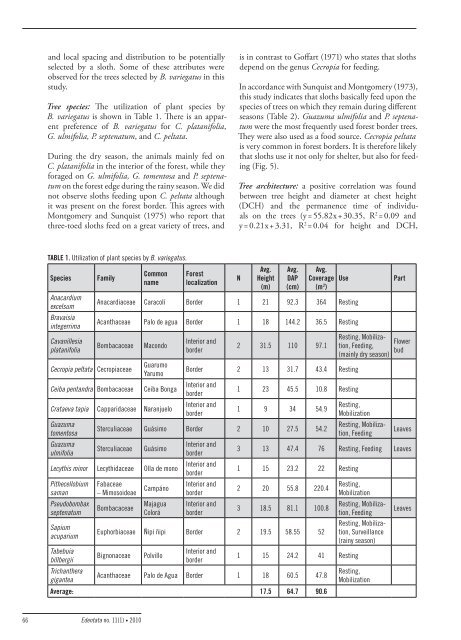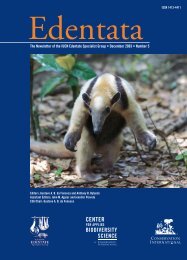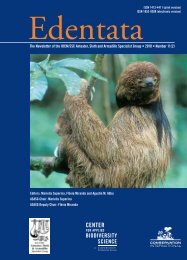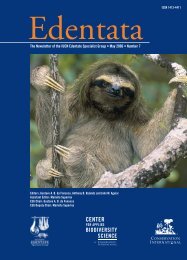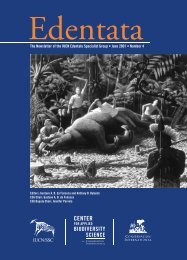Edentata 11(1) - Anteater, Sloth & Armadillo Specialist Group
Edentata 11(1) - Anteater, Sloth & Armadillo Specialist Group
Edentata 11(1) - Anteater, Sloth & Armadillo Specialist Group
Create successful ePaper yourself
Turn your PDF publications into a flip-book with our unique Google optimized e-Paper software.
and local spacing and distribution to be potentially<br />
selected by a sloth. Some of these attributes were<br />
observed for the trees selected by B. variegatus in this<br />
study.<br />
Tree species: The utilization of plant species by<br />
B. variegatus is shown in Table 1. There is an apparent<br />
preference of B. variegatus for C. platanifolia,<br />
G. ulmifolia, P. septenatum, and C. peltata.<br />
During the dry season, the animals mainly fed on<br />
C. platanifolia in the interior of the forest, while they<br />
foraged on G. ulmifolia, G. tomentosa and P. septenatum<br />
on the forest edge during the rainy season. We did<br />
not observe sloths feeding upon C. peltata although<br />
it was present on the forest border. This agrees with<br />
Montgomery and Sunquist (1975) who report that<br />
three-toed sloths feed on a great variety of trees, and<br />
is in contrast to Goffart (1971) who states that sloths<br />
depend on the genus Cecropia for feeding.<br />
In accordance with Sunquist and Montgomery (1973),<br />
this study indicates that sloths basically feed upon the<br />
species of trees on which they remain during different<br />
seasons (Table 2). Guazuma ulmifolia and P. septenatum<br />
were the most frequently used forest border trees.<br />
They were also used as a food source. Cecropia peltata<br />
is very common in forest borders. It is therefore likely<br />
that sloths use it not only for shelter, but also for feeding<br />
(Fig. 5).<br />
Tree architecture: a positive correlation was found<br />
between tree height and diameter at chest height<br />
(DCH) and the permanence time of individuals<br />
on the trees (y = 55.82 x + 30.35, R 2 = 0.09 and<br />
y = 0.21 x + 3.31, R 2 = 0.04 for height and DCH,<br />
TABLE 1. Utilization of plant species by B. variegatus.<br />
Species<br />
Anacardium<br />
excelsum<br />
Bravaisia<br />
integerrima<br />
Cavanillesia<br />
platanifolia<br />
Family<br />
Common<br />
name<br />
Forest<br />
localization<br />
N<br />
Avg.<br />
Height<br />
(m)<br />
Avg.<br />
DAP<br />
(cm)<br />
Avg.<br />
Coverage<br />
(m 2 )<br />
Anacardiaceae Caracolí Border 1 21 92.3 364 Resting<br />
Acanthaceae Palo de agua Border 1 18 144.2 36.5 Resting<br />
Bombacaceae<br />
Cecropia peltata Cecropiaceae<br />
Ceiba pentandra Bombacaceae<br />
Macondo<br />
Guarumo<br />
Yarumo<br />
Ceiba Bonga<br />
Crataeva tapia Capparidaceae Naranjuelo<br />
Guazuma<br />
tomentosa<br />
Guazuma<br />
ulmifolia<br />
Interior and<br />
border<br />
2 31.5 <strong>11</strong>0 97.1<br />
Use<br />
Border 2 13 31.7 43.4 Resting<br />
Interior and<br />
border<br />
Interior and<br />
border<br />
1 23 45.5 10.8 Resting<br />
1 9 34 54.9<br />
Sterculiaceae Guásimo Border 2 10 27.5 54.2<br />
Sterculiaceae<br />
Guásimo<br />
Lecythis minor Lecythidaceae Olla de mono<br />
Pithecellobium<br />
saman<br />
Pseudobombax<br />
septenatum<br />
Sapium<br />
acuparium<br />
Tabebuia<br />
billbergii<br />
Trichanthera<br />
gigantea<br />
Fabaceae<br />
– Mimosoideae<br />
Bombacaceae<br />
Campáno<br />
Majagua<br />
Colorá<br />
Interior and<br />
border<br />
Interior and<br />
border<br />
Interior and<br />
border<br />
Interior and<br />
border<br />
Resting, Mobilization,<br />
Feeding,<br />
(mainly dry season)<br />
Resting,<br />
Mobilization<br />
Resting, Mobilization,<br />
Feeding<br />
Part<br />
Flower<br />
bud<br />
Leaves<br />
3 13 47.4 76 Resting, Feeding Leaves<br />
1 15 23.2 22 Resting<br />
2 20 55.8 220.4<br />
3 18.5 81.1 100.8<br />
Euphorbiaceae Ñipi ñipi Border 2 19.5 58.55 52<br />
Bignonaceae<br />
Polvillo<br />
Interior and<br />
border<br />
Resting,<br />
Mobilization<br />
1 15 24.2 41 Resting<br />
Acanthaceae Palo de Agua Border 1 18 60.5 47.8<br />
Average: 17.5 64.7 90.6<br />
Resting, Mobilization,<br />
Feeding<br />
Resting, Mobilization,<br />
Surveillance<br />
(rainy season)<br />
Resting,<br />
Mobilization<br />
Leaves<br />
66<br />
<strong>Edentata</strong> no. <strong>11</strong>(1) • 2010


